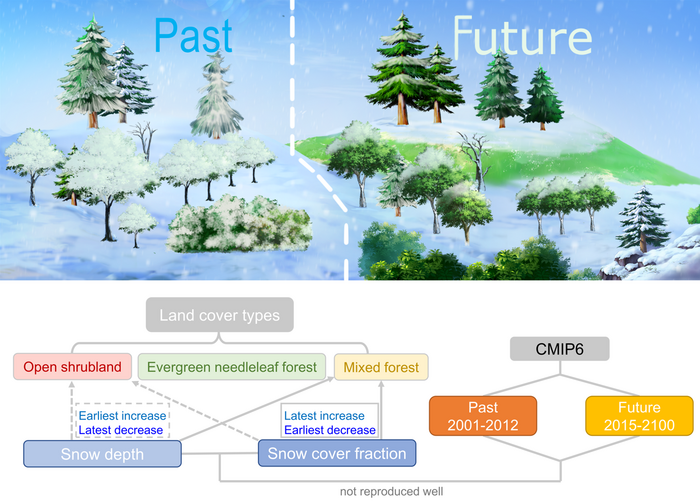Seasonal snow is a good indicator of local climate change because it is sensitive to climate change. The annual snow cover in the Northern Hemisphere is generally declining against global warming. It is crucial for climate models to be able to accurately simulate snow since it has a large impact on atmospheric circulation and the water cycle.
 Schematic illustration of the study. Image Credit: Xiaodan Guan
Schematic illustration of the study. Image Credit: Xiaodan Guan
Snow must, however, be approximated (or “parameterized”), as it is a small-scale process. As a result, numerous studies have sought to enhance the methods used to perform this parametrization of snow in climate models.
The effects of snow cover dynamics on vegetation in the mid-to-high latitudes of the Northern Hemisphere reveal significant differences among boreal biomes.
Open shrubland, mixed forest, and evergreen needle leaf forest in the mid-to-high latitudes (45°–70° N), which are extremely sensitive to snow changes, were chosen by researchers from Lanzhou University in China.
Then, they examined the special relationships between snow cover and snow depth for typical vegetation cover types over a region of North America, Europe, Central Asia, and East Asia. They also looked into how snow accumulation processes could be replicated by model parameterization. Recently, Atmospheric and Oceanic Science Letters published the findings.
The results of this study show that there are various relationships between snow cover and snow depth for these three common land cover types. These relationships can be used in a model to predict snow accumulation in addition to representing the characteristic changes in the processes of snow accumulation and snow melt.
However, partly because the influence of different land cover types is not fully considered, it was found that state-of-the-art climate models are unable to reproduce the relationships between snow cover and snow depth in both historical and future simulations, which will affect our understanding of the ecological impacts of snowmelt in spring.
Xiaodan Guan, Study First and Corresponding Author and Professor, Department of Atmospheric Science, Lanzhou University
Therefore, it is crucial to take into account how different types of land cover interact with snow processes in snow parameterization schemes to improve simulation results.
Journal Reference:
Guan, X., et al. (2022) Changes in snow parameterization over typical vegetation in the Northern Hemisphere. Atmospheric and Oceanic Science Letters. doi:10.1016/j.aosl.2022.100325.